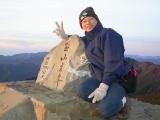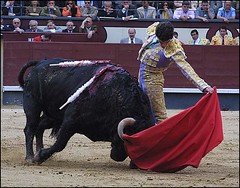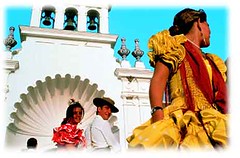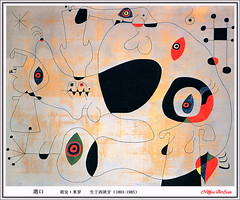西班牙的代表人物 - Jewels of Spain
Spain is a country full of contrasts, a piece of land where Romans and Phoenicians, Kelts and Iberians, Jews and Arabs have left their indelible mark in our cultural heritage. The Spanish civilization and, indeed, the Spanish people, are the result of this true melting pot of traditions, languages, colors and flavors.These unique conditions have produced throughout the centuries a vast and extremely rich array of architectural, artistic and literary testimonies which are amongst the most remarkable in western civilization. Here are some of these Spanish jewels:
Picasso, Pablo Ruiz (1881-1973), Spanish painter and sculptor, generally considered the greatest artist of the 20th century. He was unique as an inventor of forms, as an innovator of styles and techniques, as a master of various media, and as one of the most prolific artists in history. He created more than 20,000 works. more...
Francisco Jose de Goya was born on March 30, 1746, in Fuendetodos, a village in northern Spain. The family later moved to Saragossa, where Goya's father worked as a gilder. At about 14 young Goya was apprenticed to Jose Luzan, a local painter. Later he went to Italy to continue his study of art. On returning to Saragossa in 1771, he painted frescoes for the local cathedral. These works, done in the decorative rococo tradition, established Goya's artistic reputation. In 1773 he married Josefa Bayeu, sister of Saragossa artist Francisco Bayeu. The couple had many children, but only one-a son, Xavier- survived to adulthood. more...
Diego Velázquez (1599-1660) . Spain's greatest painter was also one of the supreme artists of all time. A master of technique, highly individual in style, Diego Velázquez may have had a greater influence on European art than any other painter.Diego Rodríguez de Silva Velázquez was born in Seville, Spain, presumably shortly before his baptism on June 6, 1599. His father was of noble Portuguese descent. In his teens he studied art with Francisco Pacheco, whose daughter he married. The young Velázquez once declared, "I would rather be the first painter of common things than second in higher art." He learned much from studying nature. After his marriage at the age of 19, Velázquez went to Madrid. When he was 24 he painted a portrait of Philip IV, who became his patron. more...
El Greco (1541-1614). Cretan-born painter, sculptor, and architect who settled in Spain and is regarded as the first great genius of the Spanish School. He was known as El Greco (the Greek), but his real name was Domenikos Theotocopoulos; and it was thus that he signed his paintings throughout his life, always in Greek characters, and sometimes followed by Kres (Cretan). Little is known of his youth, and only a few works survive by him in the Byzantine tradition of icon painting, notably the recently discovered Dormition of the Virgin (Church of the Koimesis tis Theotokou, Syros). In 1566 he is referred to in a Cretan document as a master painter; soon afterwards he went to Venice (Crete was then a Venetian possession), then in 1570 moved to Rome. The miniaturist Giulio Clovio, whom he met there, described him as a pupil of Titian, but of all the Venetian painters Tintoretto influenced him most, and Michelangelo's impact on his development was also important. more...
Joan Miró (1893-1983), Spanish painter, whose surrealist works, with their subject matter drawn from the realm of memory and imaginative fantasy, are some of the most original of the 20th century.Miró was born April 20, 1893, in Barcelona and studied at the Barcelona School of Fine Arts and the Academia Galí. His work before 1920 shows wide-ranging influences, including the bright colors of the Fauves, the broken forms of cubism, and the powerful, flat two-dimensionality of Catalan folk art and Romanesque church frescoes of his native Spain. He moved to Paris in 1920, where, under the influence of surrealist poets and writers, he evolved his mature style. Miró drew on memory, fantasy, and the irrational to create works of art that are visual analogues of surrealist poetry. These dreamlike visions, such as Harlequin's Carnival (1925, Albright-knox Gallery, Buffalo) or Dutch interior (1928, Museum of Modern Art, New York City), often have a whimsical or humorous quality, containing images of playfully distorted animal forms, twisted organic shapes, and odd geometric constructions.
CERVANTES SAAVEDRA, MIGUEL DE (1547-1616) , Spanish writer was born at Alcalá de Henares in the province of Madrid. His father, Rodrigo de Cervantes, was a modest surgeon, and the numerous family lived in the constant penury familiar to the younger Cervantes thoughout his unhappy life. Very little is known about his early years except that he was baptized on Oct. 9, 1547; in the next record of his life, some twenty years later, he is named as the author of a sonnet addressed to Queen Isabel of Valois, the third wife of Philip II, before her death on Oct. 3, 1568. Shortly afterward we find him as a student in the College of the City of Madrid, the principal of which was a fine humanist, Juan López de Hoyos. López de Hoyos was commissioned by the city to prepare a book reviewing all the solemnities that marked the death of the Queen, and in this volume Cervantes, designated by the editor as his "beloved and cherished pupil," figured as the author of several poems written in the name of the entire college. Thus, although these poems in no way foreshadow the future author of Don Quixote , Cervantes had already developed at the age of twenty-one a personality that attracted attention. more...
LOPE DE VEGA (1562-1635) , Spanish poet and dramatist, who ranks as the founder of the Spanish theater. Usually referred to by his Christian name alone, he was born Lope Félix de Vega Carpio in Madrid. Lope was educated at the Jesuit Colegio de los Teatinos and later at the University of Alcalá. In 1583 he became secretary to the Marquis of las Navas and, about this time, made his mark as a playwright. Entering into a passionate liaison with Elena Osorio, daughter of the actor-manager Jerónimo Velázquez and wife of another actor living in the Indies, he circulated scurrilous poems attacking her and her family when she broke off their relationship. He was arrested for libel and, brought to trial in 1588, was banished for eight years from Madrid. The memories of this sensational episode inspired the masterpiece of his old age, La Dorotea. more...
CALDERÓN DE LA BARCA, PEDRO (1600-1681) , Spanish dramatist, was born at Madrid, Jan. 17, 1600. The son of an hidalgo from the Montaña district of Asturias, Calderón was sent to a Jesuit school and later studied canon law at the universities of Alcalá and Salamanca. He left the latter university in 1620 and soon made his literary debut. His life, unlike that of his great predecessor, Lope de Vega, was largely uneventful except for a few years of foreign travel and military service. Perhaps the only incident now remembered that gives an indication of the passionate depths that underlay his poetic impulse is his daring armed entry into a convent in pursuit of a certain Pedro de Villegas, who had wounded his brother. Calderón's production of comedias for public performance ceased when he was ordained as a priest in 1651. He continued to write autos (religious plays), however, and special pieces for the court. He returned to Madrid in 1666, where he lived quietly until his death, May 25, 1681. more...
CASALS, PABLO (1876-1973), Spanish cellist, conductor, and composer, one of the foremost cello virtuosos of the 20th century. Casals was born on Dec. 29, 1876, at Vendrell, a small Catalan town southwest of Barcelona. His father, an organist and music teacher, gave him his early musical training. By the time he was 12, Casals could play several instruments. In 1888 he studied the violoncello with José García at the Municipal School of Music at Barcelona. He also studied composition and cello in Brussels and Paris. In 1897 Casals succeeded García as professor of cello at the Municipal School. more...
GRANADOS, ENRIQUE (1867-1916) , modern Spanish composer and pianist who modeled much of his music on his country's folk-idiom. He was born Pantaléon Enrique Granados y Campiña on July 27, 1867, at Lérida, Catalonia. His father, though Cuban by birth, was an officer in the Spanish army, and so the precocious child's earliest musical studies, both in piano playing and in theory, started under an army bandmaster. Soon, however, the family settled in Barcelona, where Enrique received piano instruction under Francisco X. Jurnet and Joan Baptista Pujol, and later worked at composition with Felipe Pedrell. From 1887 to 1889 Granados was in Paris, studying under Charles de Bériot, lodging with his compatriot pianist Ricardo Viñes, and reveling in an existence devoted equally to music and to bohemianism. He returned to Barcelona in 1890, a full-fledged pianist and composer, and married two years later. more...
Antoni Gaudi (b. Reus, Spain 1852; d. Barcelona, Spain 1926) The son of a coppersmith, Antoni Gaudi was born in Reus, Spain in 1852. He studied at the Escola Superior d'Arquitectura in Barcelona and designed his first major commission for the Casa Vincens in Barcelona using a Gothic Revival style that set a precedent for his future work.Over the course of his career, Gaudi developed a sensuous, curving, almost surreal design style which established him as the innovative leader of the Spanish Art Nouveau movement. With little regard for formal order, he juxtaposed unrelated systems and altered established visual order. Gaudi's characteristically warped form of Gothic architecture drew admiration from other avant-garde artists.Although categorized with the Art Nouveau, Gaudi created an entirely original style. He died in Barcelona in 1926. false
Picasso, Pablo Ruiz (1881-1973), Spanish painter and sculptor, generally considered the greatest artist of the 20th century. He was unique as an inventor of forms, as an innovator of styles and techniques, as a master of various media, and as one of the most prolific artists in history. He created more than 20,000 works. more...
Francisco Jose de Goya was born on March 30, 1746, in Fuendetodos, a village in northern Spain. The family later moved to Saragossa, where Goya's father worked as a gilder. At about 14 young Goya was apprenticed to Jose Luzan, a local painter. Later he went to Italy to continue his study of art. On returning to Saragossa in 1771, he painted frescoes for the local cathedral. These works, done in the decorative rococo tradition, established Goya's artistic reputation. In 1773 he married Josefa Bayeu, sister of Saragossa artist Francisco Bayeu. The couple had many children, but only one-a son, Xavier- survived to adulthood. more...
Diego Velázquez (1599-1660) . Spain's greatest painter was also one of the supreme artists of all time. A master of technique, highly individual in style, Diego Velázquez may have had a greater influence on European art than any other painter.Diego Rodríguez de Silva Velázquez was born in Seville, Spain, presumably shortly before his baptism on June 6, 1599. His father was of noble Portuguese descent. In his teens he studied art with Francisco Pacheco, whose daughter he married. The young Velázquez once declared, "I would rather be the first painter of common things than second in higher art." He learned much from studying nature. After his marriage at the age of 19, Velázquez went to Madrid. When he was 24 he painted a portrait of Philip IV, who became his patron. more...
El Greco (1541-1614). Cretan-born painter, sculptor, and architect who settled in Spain and is regarded as the first great genius of the Spanish School. He was known as El Greco (the Greek), but his real name was Domenikos Theotocopoulos; and it was thus that he signed his paintings throughout his life, always in Greek characters, and sometimes followed by Kres (Cretan). Little is known of his youth, and only a few works survive by him in the Byzantine tradition of icon painting, notably the recently discovered Dormition of the Virgin (Church of the Koimesis tis Theotokou, Syros). In 1566 he is referred to in a Cretan document as a master painter; soon afterwards he went to Venice (Crete was then a Venetian possession), then in 1570 moved to Rome. The miniaturist Giulio Clovio, whom he met there, described him as a pupil of Titian, but of all the Venetian painters Tintoretto influenced him most, and Michelangelo's impact on his development was also important. more...
Joan Miró (1893-1983), Spanish painter, whose surrealist works, with their subject matter drawn from the realm of memory and imaginative fantasy, are some of the most original of the 20th century.Miró was born April 20, 1893, in Barcelona and studied at the Barcelona School of Fine Arts and the Academia Galí. His work before 1920 shows wide-ranging influences, including the bright colors of the Fauves, the broken forms of cubism, and the powerful, flat two-dimensionality of Catalan folk art and Romanesque church frescoes of his native Spain. He moved to Paris in 1920, where, under the influence of surrealist poets and writers, he evolved his mature style. Miró drew on memory, fantasy, and the irrational to create works of art that are visual analogues of surrealist poetry. These dreamlike visions, such as Harlequin's Carnival (1925, Albright-knox Gallery, Buffalo) or Dutch interior (1928, Museum of Modern Art, New York City), often have a whimsical or humorous quality, containing images of playfully distorted animal forms, twisted organic shapes, and odd geometric constructions.
CERVANTES SAAVEDRA, MIGUEL DE (1547-1616) , Spanish writer was born at Alcalá de Henares in the province of Madrid. His father, Rodrigo de Cervantes, was a modest surgeon, and the numerous family lived in the constant penury familiar to the younger Cervantes thoughout his unhappy life. Very little is known about his early years except that he was baptized on Oct. 9, 1547; in the next record of his life, some twenty years later, he is named as the author of a sonnet addressed to Queen Isabel of Valois, the third wife of Philip II, before her death on Oct. 3, 1568. Shortly afterward we find him as a student in the College of the City of Madrid, the principal of which was a fine humanist, Juan López de Hoyos. López de Hoyos was commissioned by the city to prepare a book reviewing all the solemnities that marked the death of the Queen, and in this volume Cervantes, designated by the editor as his "beloved and cherished pupil," figured as the author of several poems written in the name of the entire college. Thus, although these poems in no way foreshadow the future author of Don Quixote , Cervantes had already developed at the age of twenty-one a personality that attracted attention. more...
LOPE DE VEGA (1562-1635) , Spanish poet and dramatist, who ranks as the founder of the Spanish theater. Usually referred to by his Christian name alone, he was born Lope Félix de Vega Carpio in Madrid. Lope was educated at the Jesuit Colegio de los Teatinos and later at the University of Alcalá. In 1583 he became secretary to the Marquis of las Navas and, about this time, made his mark as a playwright. Entering into a passionate liaison with Elena Osorio, daughter of the actor-manager Jerónimo Velázquez and wife of another actor living in the Indies, he circulated scurrilous poems attacking her and her family when she broke off their relationship. He was arrested for libel and, brought to trial in 1588, was banished for eight years from Madrid. The memories of this sensational episode inspired the masterpiece of his old age, La Dorotea. more...
CALDERÓN DE LA BARCA, PEDRO (1600-1681) , Spanish dramatist, was born at Madrid, Jan. 17, 1600. The son of an hidalgo from the Montaña district of Asturias, Calderón was sent to a Jesuit school and later studied canon law at the universities of Alcalá and Salamanca. He left the latter university in 1620 and soon made his literary debut. His life, unlike that of his great predecessor, Lope de Vega, was largely uneventful except for a few years of foreign travel and military service. Perhaps the only incident now remembered that gives an indication of the passionate depths that underlay his poetic impulse is his daring armed entry into a convent in pursuit of a certain Pedro de Villegas, who had wounded his brother. Calderón's production of comedias for public performance ceased when he was ordained as a priest in 1651. He continued to write autos (religious plays), however, and special pieces for the court. He returned to Madrid in 1666, where he lived quietly until his death, May 25, 1681. more...
CASALS, PABLO (1876-1973), Spanish cellist, conductor, and composer, one of the foremost cello virtuosos of the 20th century. Casals was born on Dec. 29, 1876, at Vendrell, a small Catalan town southwest of Barcelona. His father, an organist and music teacher, gave him his early musical training. By the time he was 12, Casals could play several instruments. In 1888 he studied the violoncello with José García at the Municipal School of Music at Barcelona. He also studied composition and cello in Brussels and Paris. In 1897 Casals succeeded García as professor of cello at the Municipal School. more...
GRANADOS, ENRIQUE (1867-1916) , modern Spanish composer and pianist who modeled much of his music on his country's folk-idiom. He was born Pantaléon Enrique Granados y Campiña on July 27, 1867, at Lérida, Catalonia. His father, though Cuban by birth, was an officer in the Spanish army, and so the precocious child's earliest musical studies, both in piano playing and in theory, started under an army bandmaster. Soon, however, the family settled in Barcelona, where Enrique received piano instruction under Francisco X. Jurnet and Joan Baptista Pujol, and later worked at composition with Felipe Pedrell. From 1887 to 1889 Granados was in Paris, studying under Charles de Bériot, lodging with his compatriot pianist Ricardo Viñes, and reveling in an existence devoted equally to music and to bohemianism. He returned to Barcelona in 1890, a full-fledged pianist and composer, and married two years later. more...
Antoni Gaudi (b. Reus, Spain 1852; d. Barcelona, Spain 1926) The son of a coppersmith, Antoni Gaudi was born in Reus, Spain in 1852. He studied at the Escola Superior d'Arquitectura in Barcelona and designed his first major commission for the Casa Vincens in Barcelona using a Gothic Revival style that set a precedent for his future work.Over the course of his career, Gaudi developed a sensuous, curving, almost surreal design style which established him as the innovative leader of the Spanish Art Nouveau movement. With little regard for formal order, he juxtaposed unrelated systems and altered established visual order. Gaudi's characteristically warped form of Gothic architecture drew admiration from other avant-garde artists.Although categorized with the Art Nouveau, Gaudi created an entirely original style. He died in Barcelona in 1926. false






0 Comments:
張貼留言
<< Home